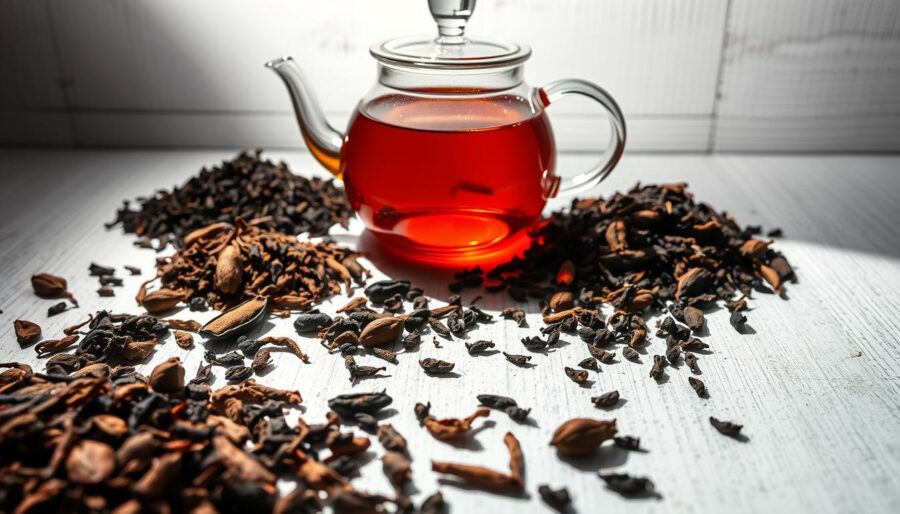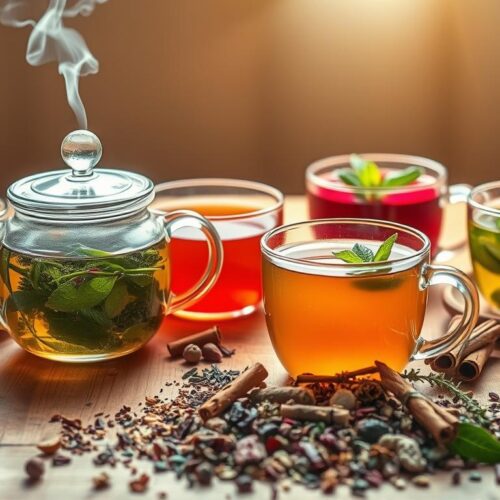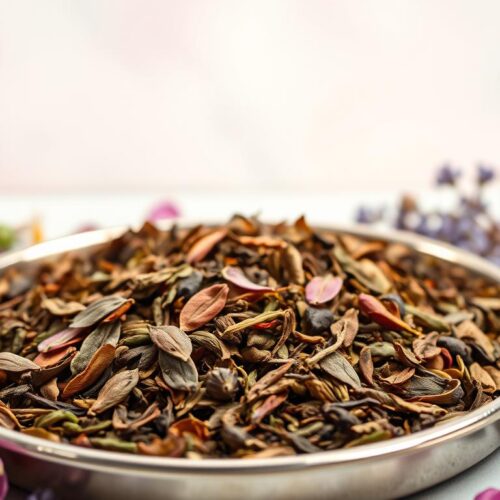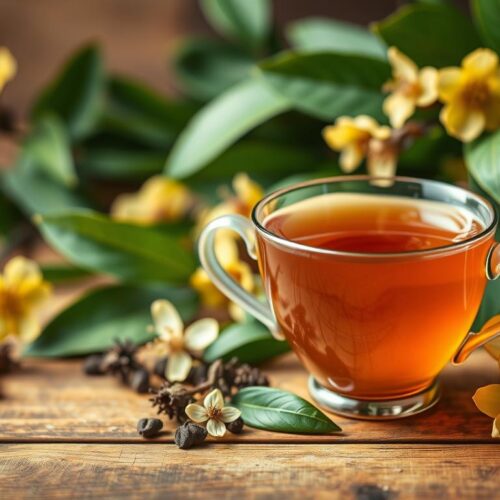You’re stepping into a broad, aromatic world defined by leaf, soil, and skill. Each black tea, originating from the Camellia sinensis plant, is unique due to its growth environment and how it’s made. From the robust taste of Assam tea to the refreshing zest of Ceylon tea, every sip tells a different story. In the United States, many people enjoy these teas as a comforting daily habit or a milder alternative to coffee in the morning.
As you discover the top black tea varieties, you’ll encounter famous ones. These include Darjeeling tea from India’s lofty gardens and Yunnan tea from the foggy mountains of China. You’ll also run into well-loved blends like English Breakfast tea from well-known brands such as Twinings and Harney & Sons. No matter if you like your tea malty, fruity, or with a hint of smoke, there’s a type that matches your palate and lifestyle.
This guide will teach how the place and time of year affect a tea’s taste. It also shows how to confidently pick between loose leaf teas and tea bags. Plus, you’ll learn the secrets to making a perfect cup of black tea. You’ll get trusted tips from tea makers and renowned sellers. Starting here, you’ll know just what to try next—and how to make it taste great on your first go.
What is Black Tea?
Black tea comes from the camellia sinensis plant. This is the same source as green, white, and pu-erh teas. It provides the strongest flavors, including malty, smoky, and sweet tastes. The names of many black teas reflect their growing areas in China, India, Sri Lanka, and Kenya.
The unique quality of black tea is its full oxidation. This process involves withering, rolling, darkening, and firing the leaves. It helps develop the warm and toasty flavors we love.
Each black tea type has a different making process. For example, Keemun tea uses a slow oxidation to bring out cocoa and floral notes. Lapsang Souchong gets a smoky flavor from drying over burning pine. This makes it great for cooking too.
The tea’s body and color come from the harvest time, leaf quality, and growing conditions. Early harvests have a fresh taste while later ones are richer. This shows how the way black tea is made and where it’s grown gives us a variety of complex flavors.
Popular Types of Black Tea
In the world of black tea, you’ll find three main types: darjeeling, assam, and earl grey. Each one has a unique origin, feel, and taste. Choose based on your preference for a delicate scent, strong flavor, or a bright, citrusy lift.
Darjeeling tea is grown in the foothills of the Himalayas in West Bengal. It’s known as the “champagne of tea.” The spring harvest offers a light, floral taste. The second flush gives a fuller flavor with muscatel notes and a hint of spice. Monsoon and autumn harvests vary in taste, with autumn offering a bolder flavor.
Assam tea comes from India’s humid Brahmaputra Valley. It has a strong, earthy taste with hints of cocoa and toast. The best quality often comes from the second harvest. It’s perfect with milk or strong by itself. This tea is great for breakfast blends and masala chai.
Earl grey tea is known for its unique scent of bergamot orange. This aroma blends with the tea to create a tangy note on top of a malty base. Twinings in London made this style famous. They offer a variant called Lady Grey with added lemon. Harney & Sons list their Earl Grey Supreme as a favorite.
| Type | Origin | Signature Flavor | Best For | Notable Details |
|---|---|---|---|---|
| Darjeeling tea | Himalayan foothills, West Bengal, India | Delicate body with muscatel notes; seasonal nuance | Afternoon sipping, light foods | Spring is floral and light; second flush is fuller and spiced; autumn is riper with higher tannins |
| Assam tea | Assam, India | Bold, malty, earthy with chocolate-like hints | Breakfast blends, masala chai, milk or no milk | Assamica variety thrives in high rainfall; second harvest often prized for strength |
| Earl grey | Blend with origins in Britain | Citrus-bright from bergamot tea essence over a malty base | Anytime refreshment, citrus-forward pairings | Popularized by Twinings; Harney & Sons offers Earl Grey Supreme; Lady Grey adds lemon nuance |
Pick earl grey when you want a fragrant lift from your tea. If you’re after a strong cup, assam tea is the way to go. For a tea with layers of aroma, darjeeling’s your choice, especially the second flush for its unique muscatel flavor.
Regional Varieties of Black Tea
Every cup of tea takes you to a different place. In Sri Lanka, ceylon tea varies with its altitude. High up, it’s a golden brew with hints of citrus and spice. Down low, it offers a fuller, burgundy-brown taste.
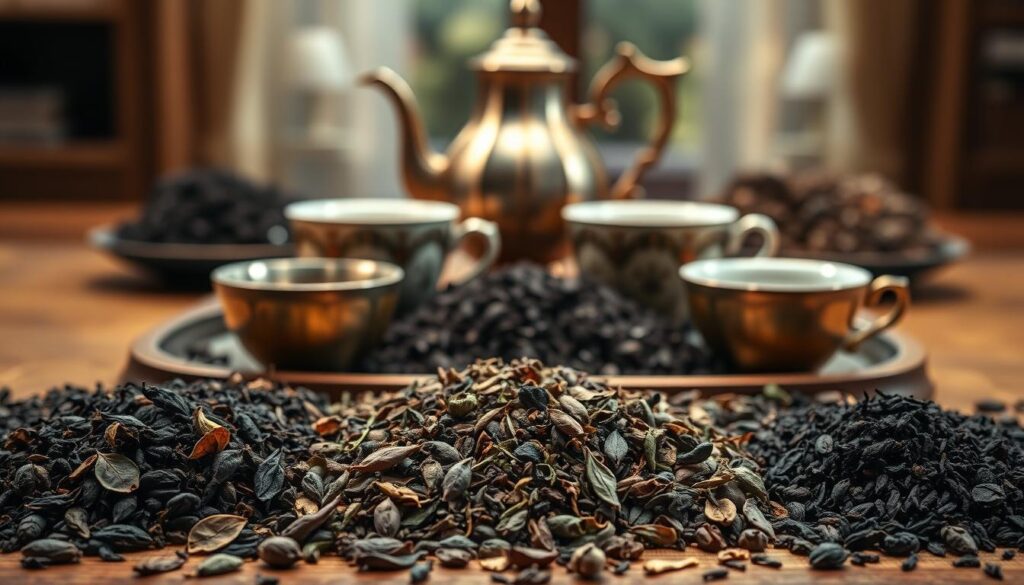
In China, the slow-oxidized keemun from Anhui has complex notes. You might taste dry wood, plum, soft flowers, a touch of pine, and dark chocolate. It’s perfect on its own, without needing milk or sugar.
Yunnan tea, or Dianhong, is full of golden tips. Boiling it reveals a brassy orange color, a smooth texture, and flavors of chocolate, honey, and a bit of pepper sweetness. It’s best enjoyed with plain snacks that don’t overpower its taste.
Lapsang souchong tea is unique, dried over pine for a smoky taste. It’s bold with smoky, resin-like flavors and a hint of tobacco and pine. Some say it reminds them of whiskey. You can drink it instead of coffee or use it to add flavor to meals.
While Japan is known for green tea, its black tea is making a name for itself. Some Japanese teas are made like Lapsang, smoked to create strong woody tastes. This gives a distinct flavor, different from the typical green teas of Japan.
- Ceylon: High-grown golden briskness vs. low-grown robust strength
- Keemun: Nuanced wood, fruit, floral, and cocoa-like tones
- Yunnan: Golden tips, rich body, honey and pepper notes
- Lapsang Souchong: Pine-smoked intensity for a bold cup
- Japanese Black: Limited production with crafted smoky styles
Flavored Black Teas
A good flavored black tea needs a strong base. It should start with Assam, Ceylon, Keemun, or Yunnan. These let added flavors stand out without hiding any bad quality. If the leaf is poor, you’ll notice it even with vanilla, citrus, or spice.
Masala chai shows how well spices work in tea, usually with an Assam base. You’ll find tastes like cinnamon, cloves, and ginger, along with black pepper. Some also have anise or nutmeg. Many enjoy chai with milk and a bit of sugar to ease the spice.
Citrus and floral teas are always favorites. Earl Grey uses bergamot for a unique taste, while Lady Grey adds extra lemon. Well-known brands like Twinings and Harney & Sons have special blends. They prove that careful flavoring enhances a good tea base.
Fruits and dessert flavors offer lots of variety. Vanilla, chocolate, and apple spice match well with a rich base. A soft Chinese tea can bring out sweet, cocoa, or subtle floral notes. The tea flavor comes first, followed by the added taste.
For something fresh and fruity, choose a Ceylon base for its zest. If you prefer a floral note, go with a Keemun or Yunnan. It gives depth and balance. Pick the base depending on the final flavor you’re after.
- Base matters: robust teas hold spice, citrus, and sweet notes without fading.
- Masala chai: spice-forward and ideal with milk for a smooth, cozy sip.
- Earl Grey and Lady Grey: bergamot-driven, bright, and versatile from morning to afternoon.
- Creative blends: from apple spice to chocolate, flavor should layer, not overpower.
Health Benefits of Black Tea
Every cup offers a tasty way to boost your health. Black tea is packed with plant compounds that protect your cells from stress. Antioxidants in the fully oxidized leaves of black tea offer strong support, even if green tea has more.
People often start their day with a strong breakfast tea from brands like Twinings or Yorkshire Tea. This habit is good for your heart, observed in those who drink tea regularly. The mix of polyphenols and caffeine in black tea helps keep your mind sharp.
The stimulant in tea, known as theine, and caffeine in coffee affect you differently. Tea’s tannins slow down caffeine absorption, so you feel awake without a sudden jump. A cup of Assam or Darjeeling might replace your second espresso, keeping you focused without the jitters.
Drinking black tea regularly does more than just wake you up. You get to enjoy its strong flavor while antioxidants work to protect your cells. This combination of taste, health benefits, and tradition is cherished from London to New York.
For sustained energy in the morning, try a hearty blend like English Breakfast or Irish Breakfast. They provide steady energy with their rich flavor and moderate caffeine. To get the best taste and health benefits, brew it right and avoid letting it steep for too long.
Brewing Techniques for Black Tea
To make the best black tea, start with filtered or spring water. Avoid tap water because it can hide the tea’s scent. Also, distilled water might make the tea taste dull. Warm up your teapot or mug first to keep the tea hot and strong.
Adjust the water temperature to your liking. For a strong taste, use water between 200–212°F. If you prefer it smoother, try water between 176–203°F. Hot water brings out a bold flavor. Cooler water will make your tea sweet and floral.
Time your steep carefully. Start tasting at three minutes, checking every half minute, and stop before five minutes for the perfect balance. Steep for just 2–3 minutes for something lighter. If it’s too strong, steep for less time next try or use cooler water.
Pick loose leaf tea for complex taste. Full leaves give a richer flavor than tea bags. Many bags use small pieces that brew fast but lack depth. For high quality, choose organic or fair trade teas from brands like Twinings or Rishi.
Match your add-ons to the tea type. Milk and sugar go well with Breakfast blends. But Darjeeling is best enjoyed plain. Lapsang Souchong can handle milk. Earl Grey is great with lemon or a little milk, depending on what you like.
Follow these guidelines for consistent taste, then adjust based on your preferences.
- Leaf-to-water: 2–3 grams per 8 oz for loose leaf; 4 grams for a stronger taste.
- Water temperature: 200–212°F for strong teas; 176–203°F for lighter ones.
- Steeping time: 3–5 minutes, tasting every 30 seconds after 3 minutes.
- Second brews: Add 30–60 seconds and slightly hotter water for a stronger flavor.
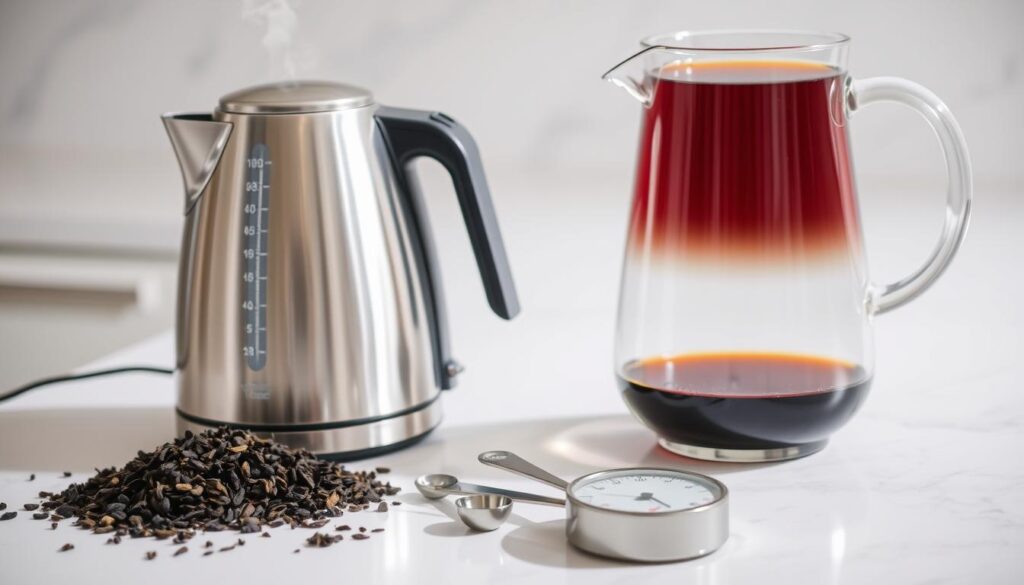
| Tea Style | Water Temperature | Steeping Time | Notes |
|---|---|---|---|
| English Breakfast / Assam | 200–212°F | 3–5 min | Rich body; great with milk and sugar |
| Darjeeling (Second Flush) | 185–200°F | 2.5–4 min | Fruity, muscatel; avoid oversteeping |
| Keemun | 185–200°F | 3–4 min | Chocolate and floral; best without additions |
| Lapsang Souchong | 200–212°F | 3–5 min | Smoky profile; can take milk |
| Earl Grey | 195–205°F | 3–4 min | Bergamot citrus; try lemon or light milk |
Keep a journal of your black tea brewing. Note down the water temperature, how long you steep, and how it tastes to you. Making small changes can help you make your perfect tea and adjust it to your taste.
Pairing Black Tea with Food
Start your day smart by choosing bold tea blends. They stand up well to milk, sugar, and big breakfast foods. English breakfast tea combines Assam, Ceylon, Kenyan leaves, and a bit of Keemun. It goes great with bacon and eggs, pancakes, or a classic diner breakfast. Just add lemon for freshness or milk for a smoother taste.
Irish Breakfast has a lot of Assam, making it darker and richer. It’s perfect with buttered toast, pastries, or scrambled eggs. Add whole milk to make it even smoother. Scottish teas are even stronger, pairing well with sausage, oats, and savory dishes.
For an afternoon snack, choose softer Chinese black teas. Keemun has a slight wood, fruit, and chocolate taste, great with cookies and light cakes. Yunnan’s honeyed chocolate flavor and bright color enhance fruit tarts and shortbread. These tea and food matches add a touch of elegance easily.
Lapsang Souchong offers a unique pine smoke flavor for savory dishes. It’s excellent with roasted nuts, grilled mushrooms, or cheddar crackers. You can even cook with it. Imagine smoked pumpkin soup or marbled eggs flavored with this smoky tea.
In the evening or with a cheese plate, look for teas that balance well. Spicy and robust Ceylon tea matches aged cheddar and salami. Assam’s deep malt taste is great with cured meats and Gouda. Yunnan’s smoothness suits Brie and prosciutto well. Lapsang’s smoky taste pairs with smoked cheeses and meats. Each tea supports an easy pairing with food.
Quick tip: Keep the water just off the boil, brew for 3–5 minutes, and taste before adding milk. This way, your English breakfast tea or other robust blend enhances the meal.
The Role of Black Tea in Culture
In the U.S., you often have black tea like English Breakfast or Chai in your kitchen. These types of tea show how traditions from faraway places reach our homes. They connect us to the world’s black tea culture.
In India, tea stalls showcase the country’s tea culture with Assam leaves, milk, and spices. This creates a strong, sweet drink that’s part of daily life and special gatherings. It’s a staple in commutes, conversations, and family traditions.
In Britain, black tea sets the day’s pace with popular morning blends and Earl Grey. Brands such as Twinings have made various black tea styles well-known. They keep the tradition alive in today’s fast-paced world.
China’s black teas, like Lapsang Souchong, have unique flavors and history. Keemun tea offers tastes of cocoa and flowers. Yunnan’s tea is known for its honey-like quality. These teas reflect the local land, tradition, and craftsmanship.
Black tea is also important during formal occasions, not just green or oolong tea. You’ll find special blends made for celebrations. These teas help bring people together to enjoy and share black tea’s global culture.
Festivals and tastings help tell black tea’s story. Blends like RMS Titanic or Queen Catherine blend history with taste. They reconnect us to the past and keep tea culture fresh every year.
| Region | Iconic Style | Cultural Touchpoint | Flavor Markers | Notable Brands |
|---|---|---|---|---|
| India | Masala Chai (Assam base) | Street-side chai, family gatherings | Spiced, malty, sweet | Tata Tea, Vahdam |
| United Kingdom | English Breakfast, Earl Grey | Morning brew, afternoon pause | Robust, citrus bergamot | Twinings, Harney & Sons |
| China | Lapsang Souchong, Keemun, Dianhong | Regional craft and heritage | Smoky, cocoa, honeyed | Wuyi Star, Teasourcing |
| United States | Breakfast blends, flavored black teas | Cafe culture, iced tea tradition | Bold, aromatic, refreshing | Harney & Sons, Bigelow |
| Middle East & North Africa | Strong black tea with mint or sugar | Hospitality and social visits | Brisk, sweet, herbal | Ahmed Tea, Alwazah (Swan) |
Buying and Storing Black Tea
For the best flavor and finest aroma, start with loose leaf tea. Loose tea leaves can bring out complex flavors and a lingering taste. Tea bags often contain smaller pieces that brew quickly but lack depth.
Look into where the tea comes from and its brewing style. Assam tea is great with milk or for baking because of its bold flavor. Darjeeling tea changes with the seasons, from a light taste in spring to a richer one in summer. Ceylon gives a citrusy spice, while Keemun has a hint of cocoa. Yunnan tea can be honey-flavored, and Lapsang tea offers a smoky taste that’s clean, not harsh.
If you care about sustainability, opt for organic black tea. Look for seals from well-known certifiers or choose Fairtrade products to help tea producers. Buying organic in bulk can also increase quality and decrease waste. Checking the harvest date can ensure you get the freshest tea with the best scent.
Try to use your tea within a few months after opening it. This is especially important for teas with strong scents like Earl Grey or chai. If you’re picking black tea at a store, look for leaves that are whole and smell fresh.
Storing tea properly is key to keeping its flavor. Use containers that are airtight and keep them in a cool, dark place. Avoid places that are damp or have strong smells. Don’t put tea in the fridge, as moisture can damage it. Store flavored teas separately so they don’t mix scents.
| Style | Signature Notes | Buying Tip | Ideal Use | Tea Storage Cue |
|---|---|---|---|---|
| Assam | Malt, bread crust, dense body | Choose orthodox loose leaf over CTC for nuance | Breakfast blends, milk and sugar | Opaque tin; keep away from spice jars |
| Darjeeling | Floral spring, muscatel summer | Seek recent flush; leaves should be fragrant and intact | Neat sipping, light sweets | Airtight tin; protect from light and humidity |
| Ceylon (Sri Lanka) | Bright citrus, gentle spice | Pick whole leaf grades for clarity | Iced tea, lemon accents | Cool cupboard; seal quickly after use |
| Keemun | Woody, cocoa, orchid hints | Look for even twists and a clean, sweet aroma | Plain, afternoon tea | Small container to limit air exposure |
| Yunnan (Dianhong) | Honeyed sweetness, golden tips | Visible golden buds signal careful processing | Neat or with a touch of sugar | Dry environment; avoid temperature swings |
| Lapsang Souchong | Clean pine smoke, resin | Choose balanced smoke; avoid harsh, acrid scent | Savory foods, cocktails | Dedicated tin; store far from delicate teas |
| Flavored Blends (Earl Grey, Chai) | Bergamot, cardamom, cinnamon | Use fresh blends; confirm natural oils when possible | Milk teas, lattes, desserts | Extra-seal pouch inside tin to preserve aromatics |
| Organic Options | Clean finish, origin-driven character | Verify certified organic black tea and fair trade labels | Daily drinking with steady quality | Keep away from sunlight; rotate stock often |
When choosing black tea, consider the type of leaves, when they were picked, and how you’ll brew it. Match strong teas with milk and enjoy lighter ones on their own. With careful buying and storage, your tea will stay fresh and delicious every time.
Exploring Black Tea Further
Dive into the world of black tea by studying its types. Begin with famous regions such as Assam, Ceylon, and Darjeeling. Also, explore Keemun, Yunnan, and Lapsang Souchong teas. Brands like Harney & Sons offer in-depth guides on blends like Earl Grey Supreme and Paris. They teach about the tea-making process and how the land affects flavor.
Many shops have detailed guides on the health perks and caffeine in black tea. They’ll help you perfect your brewing, with tips on water temperature and time. By following these tips, your tea will taste better. Remember to keep track of what works so you can enjoy it again.
Join groups that taste and compare different teas. Discuss teas like Darjeeling and Yunnan golden tips, or the unique taste of Lapsang Souchong. Try pairing teas with foods, like butter cookies or smoked pumpkin soup. Notice which teas go well with meals or desserts, and which are best alone.
As you learn more, picking your favorite tea becomes simpler. Choose Assam in the morning for its strong flavor. At lunch, go for Ceylon’s refreshing taste, and enjoy Keemun in the evening. Love Darjeeling for its seasonal changes, Yunnan for its richness, and Lapsang for its smoky touch. With the right brewing, any tea, like the classic english breakfast, can become your perfect cup.

